University Name: Social Informatics with ICT in the Workplace
VerifiedAdded on 2022/12/15
|12
|3020
|190
Essay
AI Summary
This research essay examines the significant impacts of Information and Communication Technology (ICT) on the modern workplace, focusing on the perspectives of Sherry Turkle. It explores how ICT influences various aspects, including increased speed and efficiency, fostering collaborative working environments, boosting productivity, changing office cultures, and enabling participation in the gig economy. The essay also delves into how ICT enhances the decision-making processes within organizations by improving data processing capabilities, supporting group decision-making, and accelerating the overall decision-making speed. Drawing on various research sources, the essay highlights the transformative effects of ICT, emphasizing its role in streamlining operations, enhancing communication, and driving innovation. The analysis covers how ICT has changed the workplace by considering every pre-existing configuration of services and products, which has moved towards a more scalable and flexible working environment or working form so that it is possible to focus on quality circles in the workplace. Overall, the essay provides a comprehensive overview of how ICT has become integral to the contemporary workplace and its effects on both workers and organizational strategies.
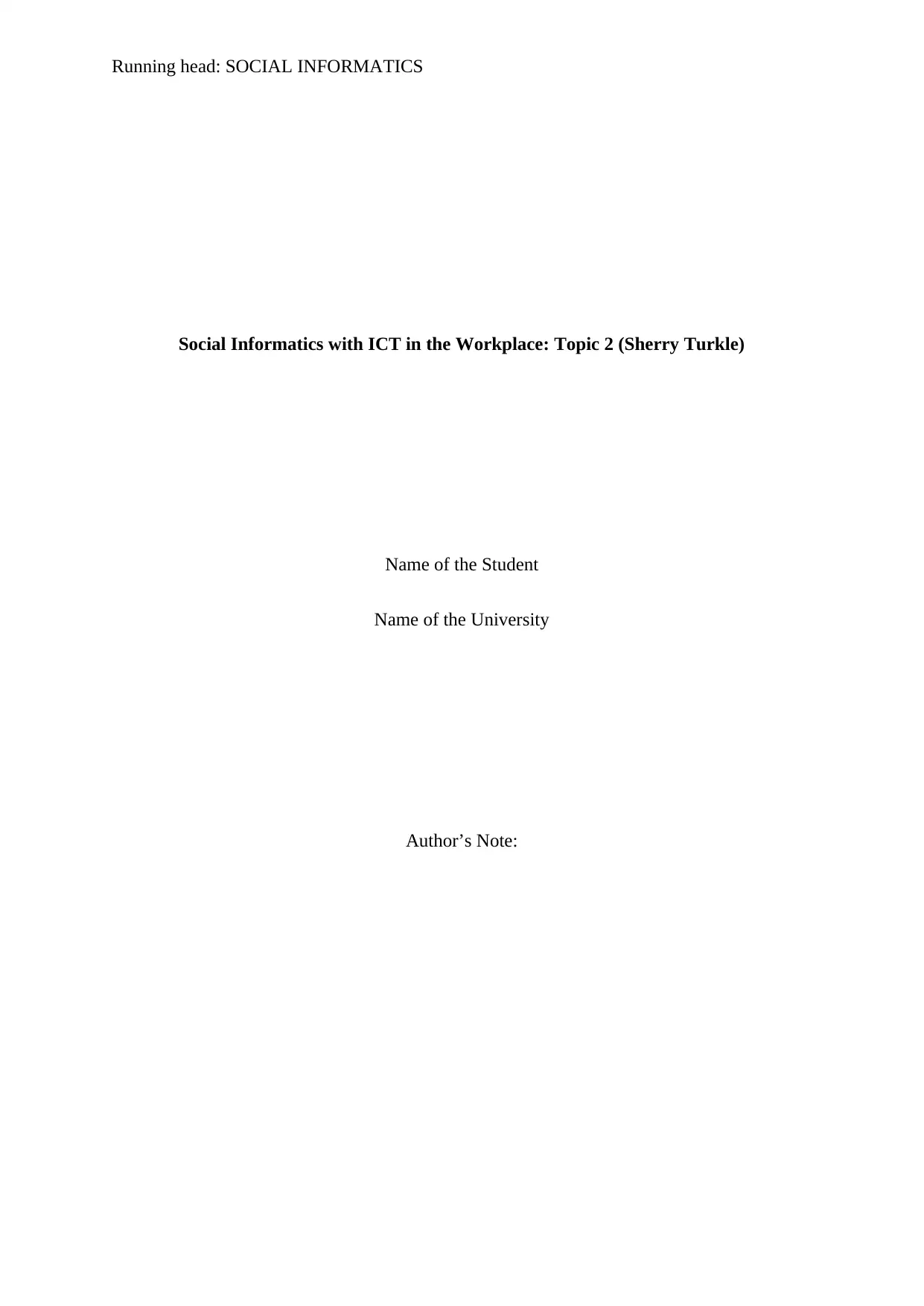
Running head: SOCIAL INFORMATICS
Social Informatics with ICT in the Workplace: Topic 2 (Sherry Turkle)
Name of the Student
Name of the University
Author’s Note:
Social Informatics with ICT in the Workplace: Topic 2 (Sherry Turkle)
Name of the Student
Name of the University
Author’s Note:
Paraphrase This Document
Need a fresh take? Get an instant paraphrase of this document with our AI Paraphraser
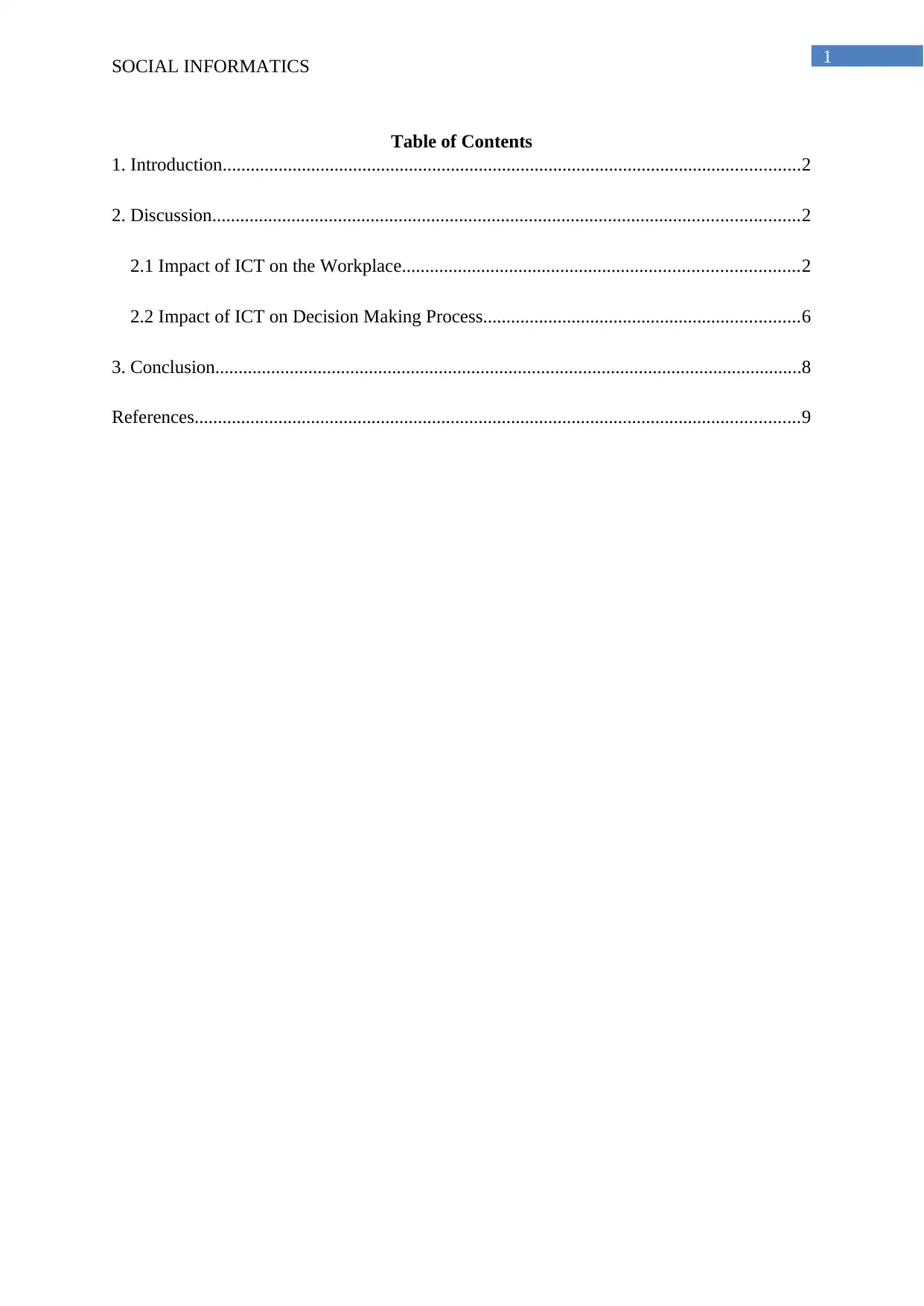
1
SOCIAL INFORMATICS
Table of Contents
1. Introduction............................................................................................................................2
2. Discussion..............................................................................................................................2
2.1 Impact of ICT on the Workplace.....................................................................................2
2.2 Impact of ICT on Decision Making Process....................................................................6
3. Conclusion..............................................................................................................................8
References..................................................................................................................................9
SOCIAL INFORMATICS
Table of Contents
1. Introduction............................................................................................................................2
2. Discussion..............................................................................................................................2
2.1 Impact of ICT on the Workplace.....................................................................................2
2.2 Impact of ICT on Decision Making Process....................................................................6
3. Conclusion..............................................................................................................................8
References..................................................................................................................................9
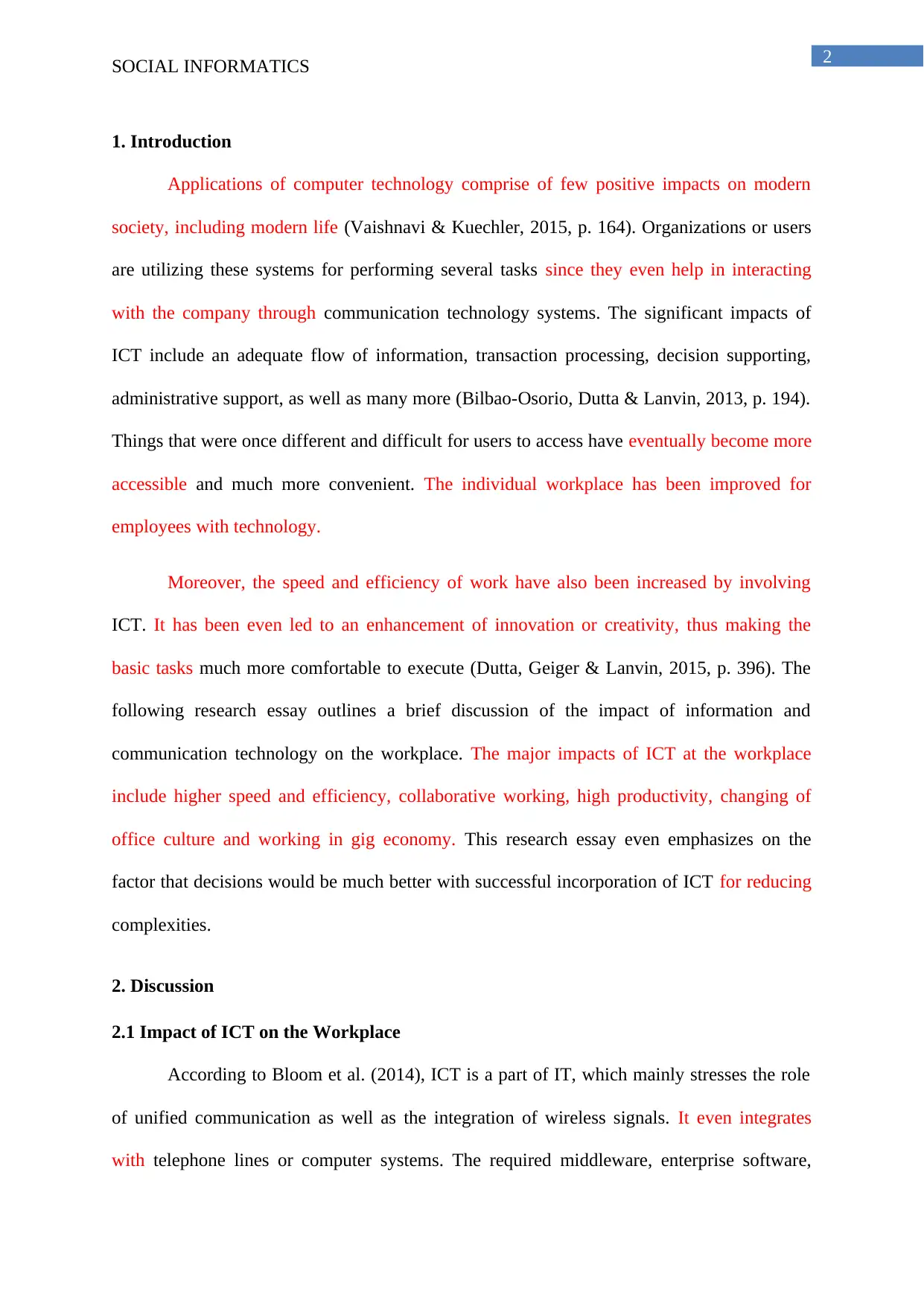
2
SOCIAL INFORMATICS
1. Introduction
Applications of computer technology comprise of few positive impacts on modern
society, including modern life (Vaishnavi & Kuechler, 2015, p. 164). Organizations or users
are utilizing these systems for performing several tasks since they even help in interacting
with the company through communication technology systems. The significant impacts of
ICT include an adequate flow of information, transaction processing, decision supporting,
administrative support, as well as many more (Bilbao-Osorio, Dutta & Lanvin, 2013, p. 194).
Things that were once different and difficult for users to access have eventually become more
accessible and much more convenient. The individual workplace has been improved for
employees with technology.
Moreover, the speed and efficiency of work have also been increased by involving
ICT. It has been even led to an enhancement of innovation or creativity, thus making the
basic tasks much more comfortable to execute (Dutta, Geiger & Lanvin, 2015, p. 396). The
following research essay outlines a brief discussion of the impact of information and
communication technology on the workplace. The major impacts of ICT at the workplace
include higher speed and efficiency, collaborative working, high productivity, changing of
office culture and working in gig economy. This research essay even emphasizes on the
factor that decisions would be much better with successful incorporation of ICT for reducing
complexities.
2. Discussion
2.1 Impact of ICT on the Workplace
According to Bloom et al. (2014), ICT is a part of IT, which mainly stresses the role
of unified communication as well as the integration of wireless signals. It even integrates
with telephone lines or computer systems. The required middleware, enterprise software,
SOCIAL INFORMATICS
1. Introduction
Applications of computer technology comprise of few positive impacts on modern
society, including modern life (Vaishnavi & Kuechler, 2015, p. 164). Organizations or users
are utilizing these systems for performing several tasks since they even help in interacting
with the company through communication technology systems. The significant impacts of
ICT include an adequate flow of information, transaction processing, decision supporting,
administrative support, as well as many more (Bilbao-Osorio, Dutta & Lanvin, 2013, p. 194).
Things that were once different and difficult for users to access have eventually become more
accessible and much more convenient. The individual workplace has been improved for
employees with technology.
Moreover, the speed and efficiency of work have also been increased by involving
ICT. It has been even led to an enhancement of innovation or creativity, thus making the
basic tasks much more comfortable to execute (Dutta, Geiger & Lanvin, 2015, p. 396). The
following research essay outlines a brief discussion of the impact of information and
communication technology on the workplace. The major impacts of ICT at the workplace
include higher speed and efficiency, collaborative working, high productivity, changing of
office culture and working in gig economy. This research essay even emphasizes on the
factor that decisions would be much better with successful incorporation of ICT for reducing
complexities.
2. Discussion
2.1 Impact of ICT on the Workplace
According to Bloom et al. (2014), ICT is a part of IT, which mainly stresses the role
of unified communication as well as the integration of wireless signals. It even integrates
with telephone lines or computer systems. The required middleware, enterprise software,
⊘ This is a preview!⊘
Do you want full access?
Subscribe today to unlock all pages.

Trusted by 1+ million students worldwide
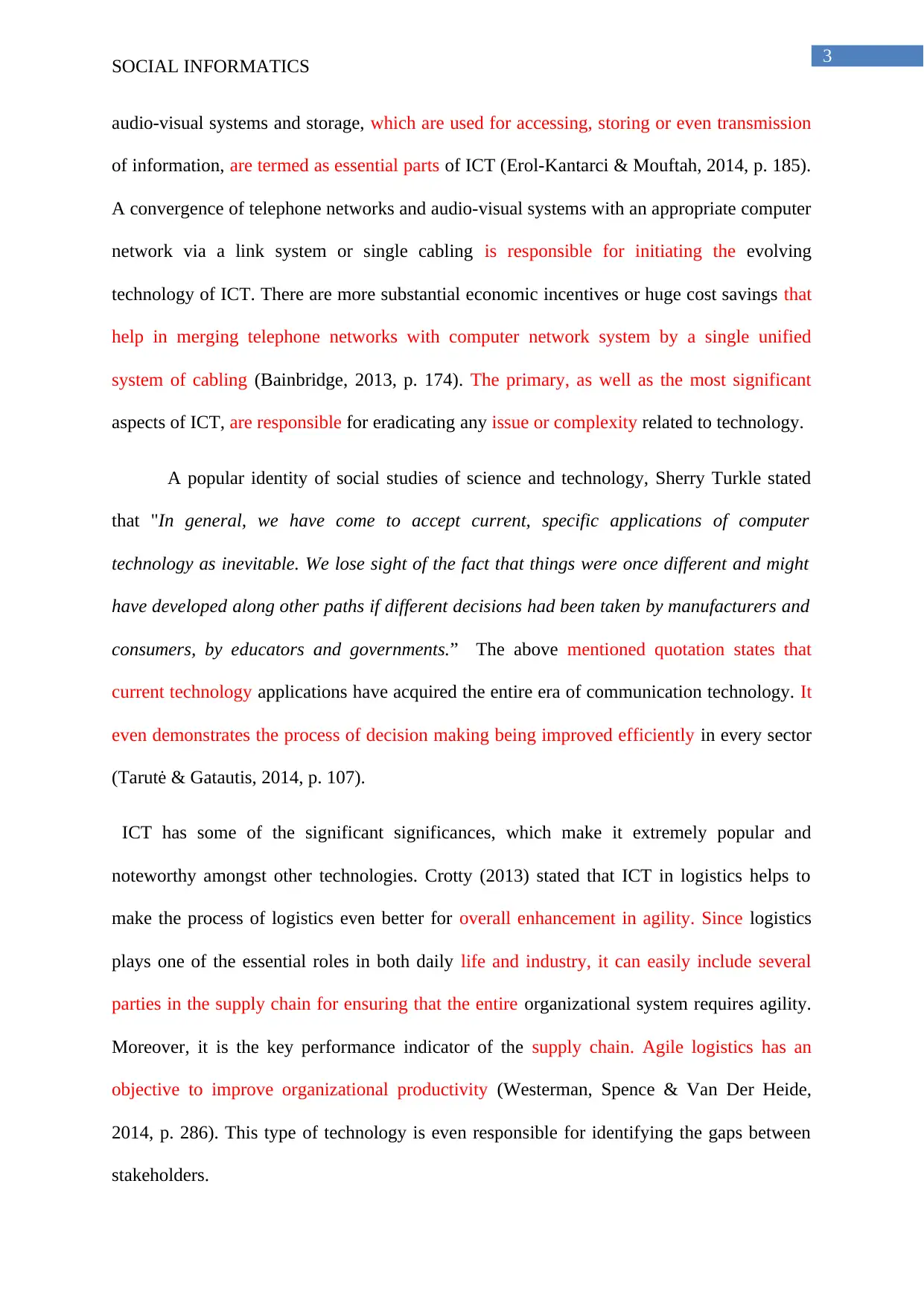
3
SOCIAL INFORMATICS
audio-visual systems and storage, which are used for accessing, storing or even transmission
of information, are termed as essential parts of ICT (Erol-Kantarci & Mouftah, 2014, p. 185).
A convergence of telephone networks and audio-visual systems with an appropriate computer
network via a link system or single cabling is responsible for initiating the evolving
technology of ICT. There are more substantial economic incentives or huge cost savings that
help in merging telephone networks with computer network system by a single unified
system of cabling (Bainbridge, 2013, p. 174). The primary, as well as the most significant
aspects of ICT, are responsible for eradicating any issue or complexity related to technology.
A popular identity of social studies of science and technology, Sherry Turkle stated
that "In general, we have come to accept current, specific applications of computer
technology as inevitable. We lose sight of the fact that things were once different and might
have developed along other paths if different decisions had been taken by manufacturers and
consumers, by educators and governments.” The above mentioned quotation states that
current technology applications have acquired the entire era of communication technology. It
even demonstrates the process of decision making being improved efficiently in every sector
(Tarutė & Gatautis, 2014, p. 107).
ICT has some of the significant significances, which make it extremely popular and
noteworthy amongst other technologies. Crotty (2013) stated that ICT in logistics helps to
make the process of logistics even better for overall enhancement in agility. Since logistics
plays one of the essential roles in both daily life and industry, it can easily include several
parties in the supply chain for ensuring that the entire organizational system requires agility.
Moreover, it is the key performance indicator of the supply chain. Agile logistics has an
objective to improve organizational productivity (Westerman, Spence & Van Der Heide,
2014, p. 286). This type of technology is even responsible for identifying the gaps between
stakeholders.
SOCIAL INFORMATICS
audio-visual systems and storage, which are used for accessing, storing or even transmission
of information, are termed as essential parts of ICT (Erol-Kantarci & Mouftah, 2014, p. 185).
A convergence of telephone networks and audio-visual systems with an appropriate computer
network via a link system or single cabling is responsible for initiating the evolving
technology of ICT. There are more substantial economic incentives or huge cost savings that
help in merging telephone networks with computer network system by a single unified
system of cabling (Bainbridge, 2013, p. 174). The primary, as well as the most significant
aspects of ICT, are responsible for eradicating any issue or complexity related to technology.
A popular identity of social studies of science and technology, Sherry Turkle stated
that "In general, we have come to accept current, specific applications of computer
technology as inevitable. We lose sight of the fact that things were once different and might
have developed along other paths if different decisions had been taken by manufacturers and
consumers, by educators and governments.” The above mentioned quotation states that
current technology applications have acquired the entire era of communication technology. It
even demonstrates the process of decision making being improved efficiently in every sector
(Tarutė & Gatautis, 2014, p. 107).
ICT has some of the significant significances, which make it extremely popular and
noteworthy amongst other technologies. Crotty (2013) stated that ICT in logistics helps to
make the process of logistics even better for overall enhancement in agility. Since logistics
plays one of the essential roles in both daily life and industry, it can easily include several
parties in the supply chain for ensuring that the entire organizational system requires agility.
Moreover, it is the key performance indicator of the supply chain. Agile logistics has an
objective to improve organizational productivity (Westerman, Spence & Van Der Heide,
2014, p. 286). This type of technology is even responsible for identifying the gaps between
stakeholders.
Paraphrase This Document
Need a fresh take? Get an instant paraphrase of this document with our AI Paraphraser
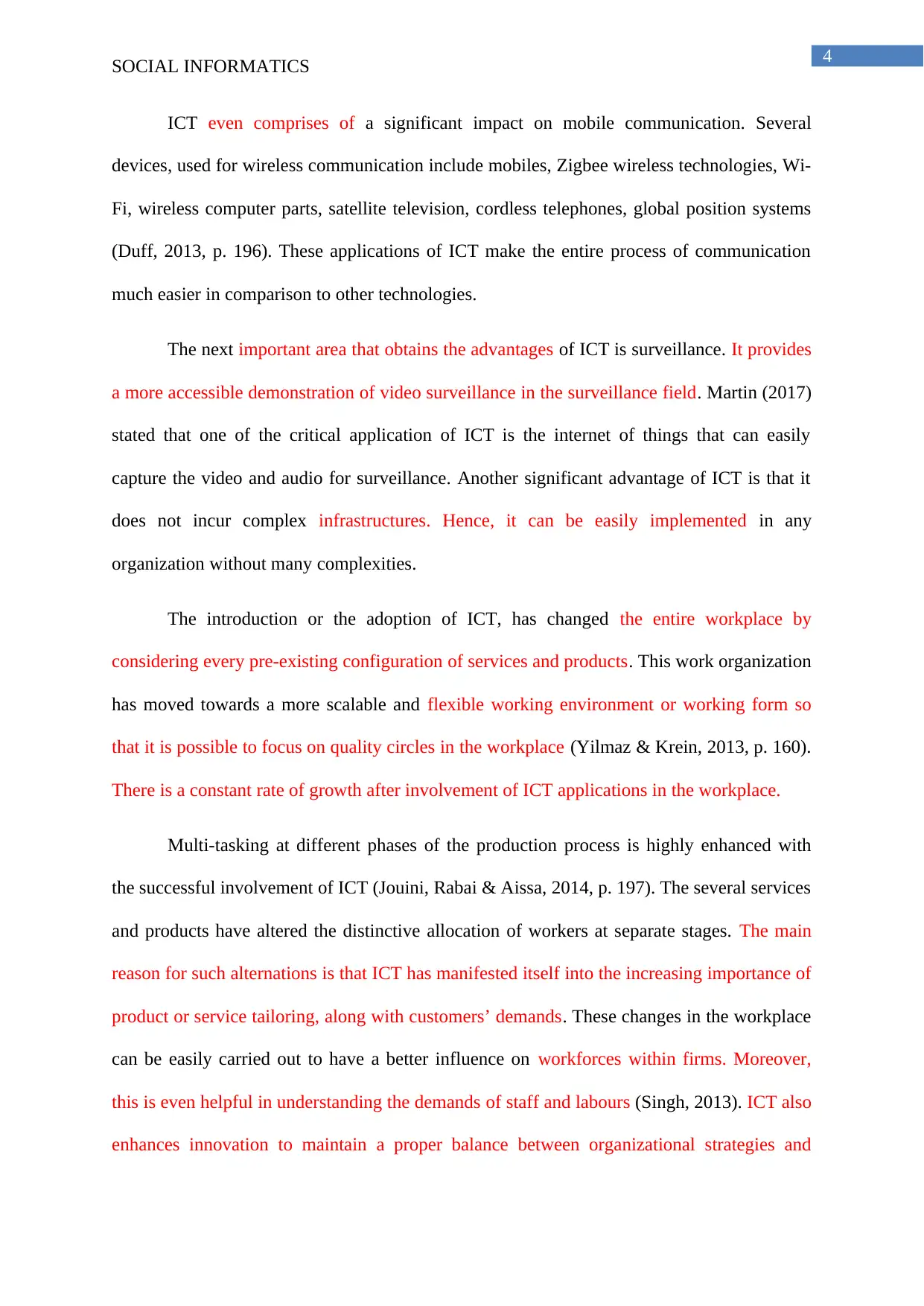
4
SOCIAL INFORMATICS
ICT even comprises of a significant impact on mobile communication. Several
devices, used for wireless communication include mobiles, Zigbee wireless technologies, Wi-
Fi, wireless computer parts, satellite television, cordless telephones, global position systems
(Duff, 2013, p. 196). These applications of ICT make the entire process of communication
much easier in comparison to other technologies.
The next important area that obtains the advantages of ICT is surveillance. It provides
a more accessible demonstration of video surveillance in the surveillance field. Martin (2017)
stated that one of the critical application of ICT is the internet of things that can easily
capture the video and audio for surveillance. Another significant advantage of ICT is that it
does not incur complex infrastructures. Hence, it can be easily implemented in any
organization without many complexities.
The introduction or the adoption of ICT, has changed the entire workplace by
considering every pre-existing configuration of services and products. This work organization
has moved towards a more scalable and flexible working environment or working form so
that it is possible to focus on quality circles in the workplace (Yilmaz & Krein, 2013, p. 160).
There is a constant rate of growth after involvement of ICT applications in the workplace.
Multi-tasking at different phases of the production process is highly enhanced with
the successful involvement of ICT (Jouini, Rabai & Aissa, 2014, p. 197). The several services
and products have altered the distinctive allocation of workers at separate stages. The main
reason for such alternations is that ICT has manifested itself into the increasing importance of
product or service tailoring, along with customers’ demands. These changes in the workplace
can be easily carried out to have a better influence on workforces within firms. Moreover,
this is even helpful in understanding the demands of staff and labours (Singh, 2013). ICT also
enhances innovation to maintain a proper balance between organizational strategies and
SOCIAL INFORMATICS
ICT even comprises of a significant impact on mobile communication. Several
devices, used for wireless communication include mobiles, Zigbee wireless technologies, Wi-
Fi, wireless computer parts, satellite television, cordless telephones, global position systems
(Duff, 2013, p. 196). These applications of ICT make the entire process of communication
much easier in comparison to other technologies.
The next important area that obtains the advantages of ICT is surveillance. It provides
a more accessible demonstration of video surveillance in the surveillance field. Martin (2017)
stated that one of the critical application of ICT is the internet of things that can easily
capture the video and audio for surveillance. Another significant advantage of ICT is that it
does not incur complex infrastructures. Hence, it can be easily implemented in any
organization without many complexities.
The introduction or the adoption of ICT, has changed the entire workplace by
considering every pre-existing configuration of services and products. This work organization
has moved towards a more scalable and flexible working environment or working form so
that it is possible to focus on quality circles in the workplace (Yilmaz & Krein, 2013, p. 160).
There is a constant rate of growth after involvement of ICT applications in the workplace.
Multi-tasking at different phases of the production process is highly enhanced with
the successful involvement of ICT (Jouini, Rabai & Aissa, 2014, p. 197). The several services
and products have altered the distinctive allocation of workers at separate stages. The main
reason for such alternations is that ICT has manifested itself into the increasing importance of
product or service tailoring, along with customers’ demands. These changes in the workplace
can be easily carried out to have a better influence on workforces within firms. Moreover,
this is even helpful in understanding the demands of staff and labours (Singh, 2013). ICT also
enhances innovation to maintain a proper balance between organizational strategies and
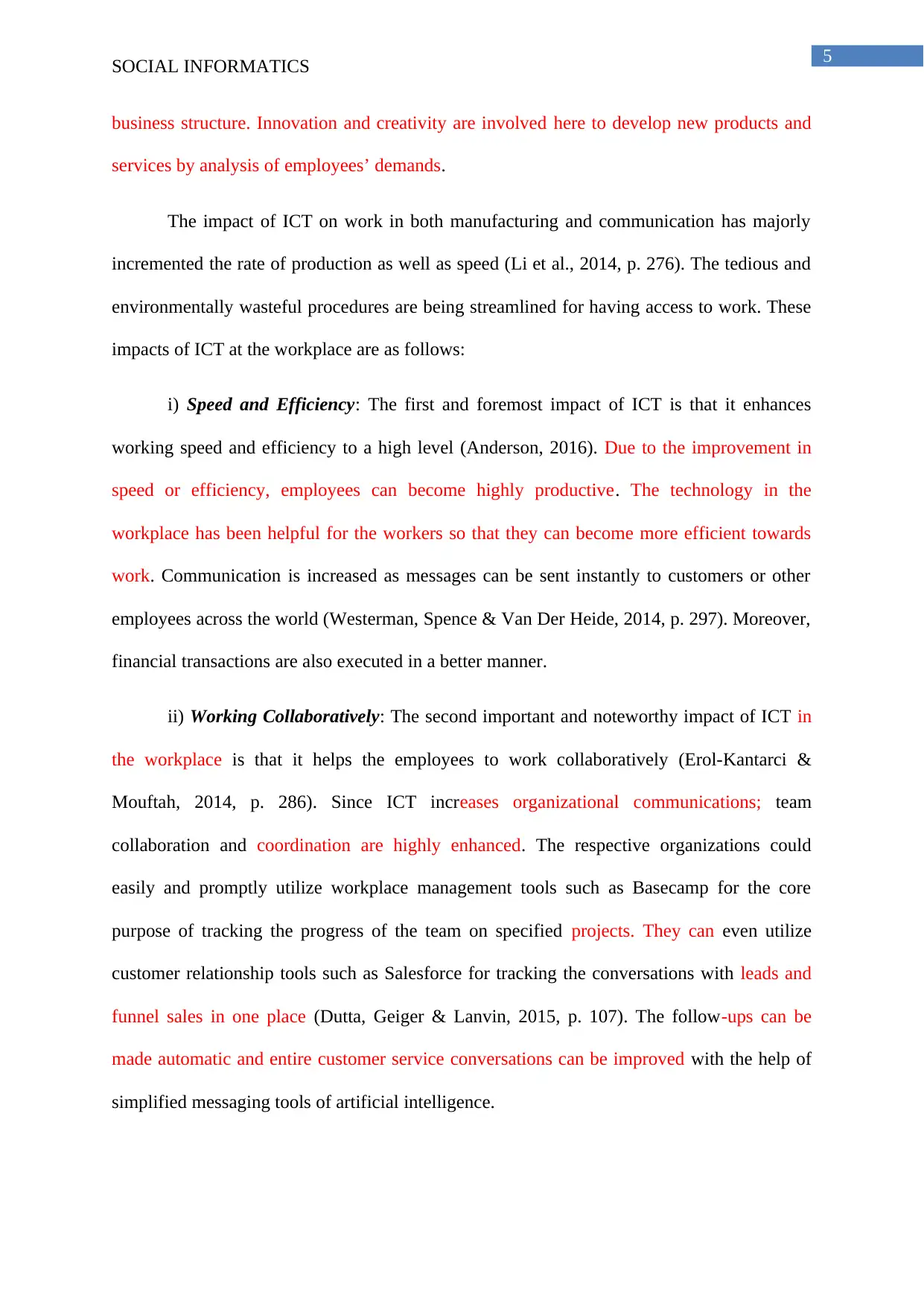
5
SOCIAL INFORMATICS
business structure. Innovation and creativity are involved here to develop new products and
services by analysis of employees’ demands.
The impact of ICT on work in both manufacturing and communication has majorly
incremented the rate of production as well as speed (Li et al., 2014, p. 276). The tedious and
environmentally wasteful procedures are being streamlined for having access to work. These
impacts of ICT at the workplace are as follows:
i) Speed and Efficiency: The first and foremost impact of ICT is that it enhances
working speed and efficiency to a high level (Anderson, 2016). Due to the improvement in
speed or efficiency, employees can become highly productive. The technology in the
workplace has been helpful for the workers so that they can become more efficient towards
work. Communication is increased as messages can be sent instantly to customers or other
employees across the world (Westerman, Spence & Van Der Heide, 2014, p. 297). Moreover,
financial transactions are also executed in a better manner.
ii) Working Collaboratively: The second important and noteworthy impact of ICT in
the workplace is that it helps the employees to work collaboratively (Erol-Kantarci &
Mouftah, 2014, p. 286). Since ICT increases organizational communications; team
collaboration and coordination are highly enhanced. The respective organizations could
easily and promptly utilize workplace management tools such as Basecamp for the core
purpose of tracking the progress of the team on specified projects. They can even utilize
customer relationship tools such as Salesforce for tracking the conversations with leads and
funnel sales in one place (Dutta, Geiger & Lanvin, 2015, p. 107). The follow-ups can be
made automatic and entire customer service conversations can be improved with the help of
simplified messaging tools of artificial intelligence.
SOCIAL INFORMATICS
business structure. Innovation and creativity are involved here to develop new products and
services by analysis of employees’ demands.
The impact of ICT on work in both manufacturing and communication has majorly
incremented the rate of production as well as speed (Li et al., 2014, p. 276). The tedious and
environmentally wasteful procedures are being streamlined for having access to work. These
impacts of ICT at the workplace are as follows:
i) Speed and Efficiency: The first and foremost impact of ICT is that it enhances
working speed and efficiency to a high level (Anderson, 2016). Due to the improvement in
speed or efficiency, employees can become highly productive. The technology in the
workplace has been helpful for the workers so that they can become more efficient towards
work. Communication is increased as messages can be sent instantly to customers or other
employees across the world (Westerman, Spence & Van Der Heide, 2014, p. 297). Moreover,
financial transactions are also executed in a better manner.
ii) Working Collaboratively: The second important and noteworthy impact of ICT in
the workplace is that it helps the employees to work collaboratively (Erol-Kantarci &
Mouftah, 2014, p. 286). Since ICT increases organizational communications; team
collaboration and coordination are highly enhanced. The respective organizations could
easily and promptly utilize workplace management tools such as Basecamp for the core
purpose of tracking the progress of the team on specified projects. They can even utilize
customer relationship tools such as Salesforce for tracking the conversations with leads and
funnel sales in one place (Dutta, Geiger & Lanvin, 2015, p. 107). The follow-ups can be
made automatic and entire customer service conversations can be improved with the help of
simplified messaging tools of artificial intelligence.
⊘ This is a preview!⊘
Do you want full access?
Subscribe today to unlock all pages.

Trusted by 1+ million students worldwide
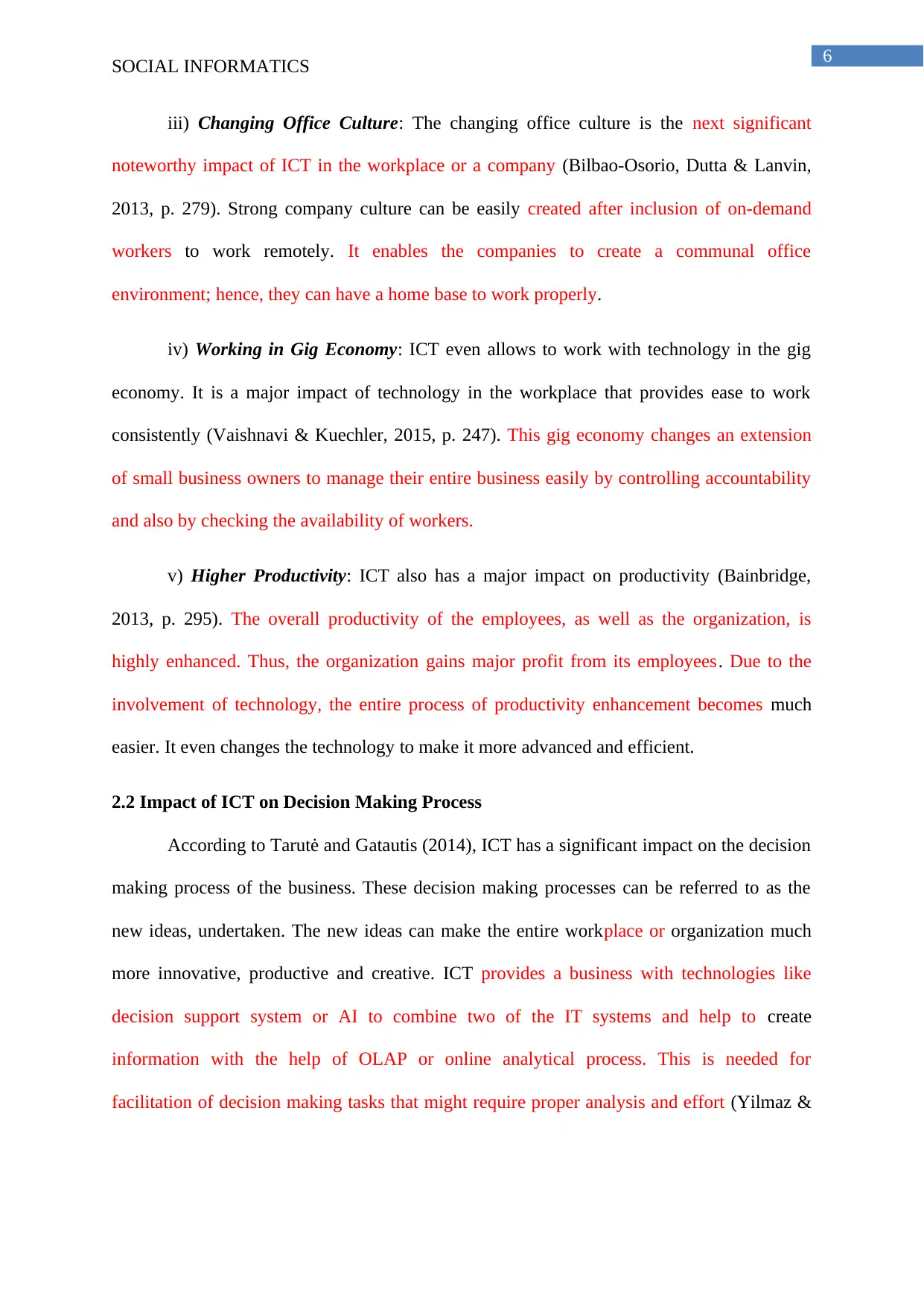
6
SOCIAL INFORMATICS
iii) Changing Office Culture: The changing office culture is the next significant
noteworthy impact of ICT in the workplace or a company (Bilbao-Osorio, Dutta & Lanvin,
2013, p. 279). Strong company culture can be easily created after inclusion of on-demand
workers to work remotely. It enables the companies to create a communal office
environment; hence, they can have a home base to work properly.
iv) Working in Gig Economy: ICT even allows to work with technology in the gig
economy. It is a major impact of technology in the workplace that provides ease to work
consistently (Vaishnavi & Kuechler, 2015, p. 247). This gig economy changes an extension
of small business owners to manage their entire business easily by controlling accountability
and also by checking the availability of workers.
v) Higher Productivity: ICT also has a major impact on productivity (Bainbridge,
2013, p. 295). The overall productivity of the employees, as well as the organization, is
highly enhanced. Thus, the organization gains major profit from its employees. Due to the
involvement of technology, the entire process of productivity enhancement becomes much
easier. It even changes the technology to make it more advanced and efficient.
2.2 Impact of ICT on Decision Making Process
According to Tarutė and Gatautis (2014), ICT has a significant impact on the decision
making process of the business. These decision making processes can be referred to as the
new ideas, undertaken. The new ideas can make the entire workplace or organization much
more innovative, productive and creative. ICT provides a business with technologies like
decision support system or AI to combine two of the IT systems and help to create
information with the help of OLAP or online analytical process. This is needed for
facilitation of decision making tasks that might require proper analysis and effort (Yilmaz &
SOCIAL INFORMATICS
iii) Changing Office Culture: The changing office culture is the next significant
noteworthy impact of ICT in the workplace or a company (Bilbao-Osorio, Dutta & Lanvin,
2013, p. 279). Strong company culture can be easily created after inclusion of on-demand
workers to work remotely. It enables the companies to create a communal office
environment; hence, they can have a home base to work properly.
iv) Working in Gig Economy: ICT even allows to work with technology in the gig
economy. It is a major impact of technology in the workplace that provides ease to work
consistently (Vaishnavi & Kuechler, 2015, p. 247). This gig economy changes an extension
of small business owners to manage their entire business easily by controlling accountability
and also by checking the availability of workers.
v) Higher Productivity: ICT also has a major impact on productivity (Bainbridge,
2013, p. 295). The overall productivity of the employees, as well as the organization, is
highly enhanced. Thus, the organization gains major profit from its employees. Due to the
involvement of technology, the entire process of productivity enhancement becomes much
easier. It even changes the technology to make it more advanced and efficient.
2.2 Impact of ICT on Decision Making Process
According to Tarutė and Gatautis (2014), ICT has a significant impact on the decision
making process of the business. These decision making processes can be referred to as the
new ideas, undertaken. The new ideas can make the entire workplace or organization much
more innovative, productive and creative. ICT provides a business with technologies like
decision support system or AI to combine two of the IT systems and help to create
information with the help of OLAP or online analytical process. This is needed for
facilitation of decision making tasks that might require proper analysis and effort (Yilmaz &
Paraphrase This Document
Need a fresh take? Get an instant paraphrase of this document with our AI Paraphraser
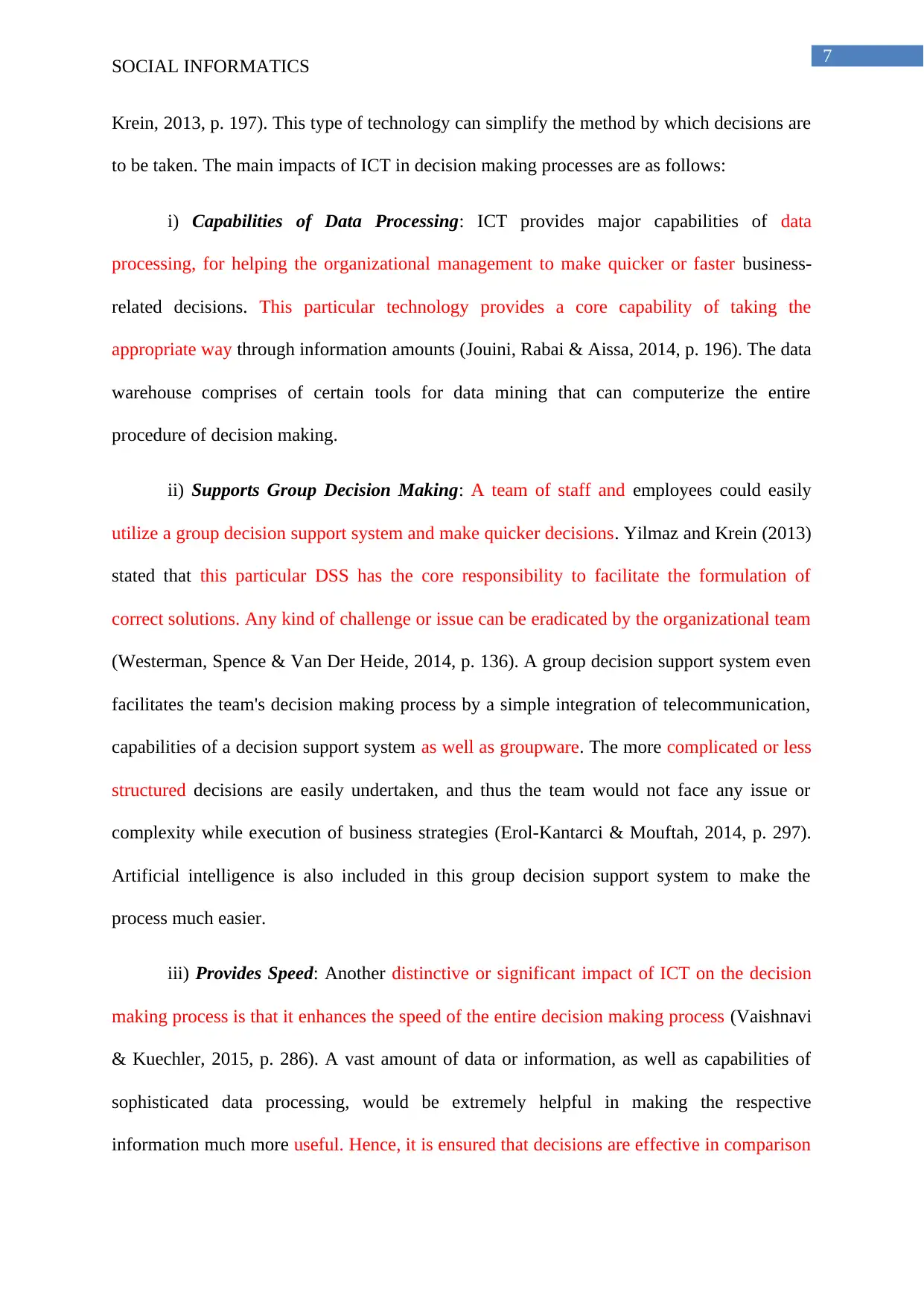
7
SOCIAL INFORMATICS
Krein, 2013, p. 197). This type of technology can simplify the method by which decisions are
to be taken. The main impacts of ICT in decision making processes are as follows:
i) Capabilities of Data Processing: ICT provides major capabilities of data
processing, for helping the organizational management to make quicker or faster business-
related decisions. This particular technology provides a core capability of taking the
appropriate way through information amounts (Jouini, Rabai & Aissa, 2014, p. 196). The data
warehouse comprises of certain tools for data mining that can computerize the entire
procedure of decision making.
ii) Supports Group Decision Making: A team of staff and employees could easily
utilize a group decision support system and make quicker decisions. Yilmaz and Krein (2013)
stated that this particular DSS has the core responsibility to facilitate the formulation of
correct solutions. Any kind of challenge or issue can be eradicated by the organizational team
(Westerman, Spence & Van Der Heide, 2014, p. 136). A group decision support system even
facilitates the team's decision making process by a simple integration of telecommunication,
capabilities of a decision support system as well as groupware. The more complicated or less
structured decisions are easily undertaken, and thus the team would not face any issue or
complexity while execution of business strategies (Erol-Kantarci & Mouftah, 2014, p. 297).
Artificial intelligence is also included in this group decision support system to make the
process much easier.
iii) Provides Speed: Another distinctive or significant impact of ICT on the decision
making process is that it enhances the speed of the entire decision making process (Vaishnavi
& Kuechler, 2015, p. 286). A vast amount of data or information, as well as capabilities of
sophisticated data processing, would be extremely helpful in making the respective
information much more useful. Hence, it is ensured that decisions are effective in comparison
SOCIAL INFORMATICS
Krein, 2013, p. 197). This type of technology can simplify the method by which decisions are
to be taken. The main impacts of ICT in decision making processes are as follows:
i) Capabilities of Data Processing: ICT provides major capabilities of data
processing, for helping the organizational management to make quicker or faster business-
related decisions. This particular technology provides a core capability of taking the
appropriate way through information amounts (Jouini, Rabai & Aissa, 2014, p. 196). The data
warehouse comprises of certain tools for data mining that can computerize the entire
procedure of decision making.
ii) Supports Group Decision Making: A team of staff and employees could easily
utilize a group decision support system and make quicker decisions. Yilmaz and Krein (2013)
stated that this particular DSS has the core responsibility to facilitate the formulation of
correct solutions. Any kind of challenge or issue can be eradicated by the organizational team
(Westerman, Spence & Van Der Heide, 2014, p. 136). A group decision support system even
facilitates the team's decision making process by a simple integration of telecommunication,
capabilities of a decision support system as well as groupware. The more complicated or less
structured decisions are easily undertaken, and thus the team would not face any issue or
complexity while execution of business strategies (Erol-Kantarci & Mouftah, 2014, p. 297).
Artificial intelligence is also included in this group decision support system to make the
process much easier.
iii) Provides Speed: Another distinctive or significant impact of ICT on the decision
making process is that it enhances the speed of the entire decision making process (Vaishnavi
& Kuechler, 2015, p. 286). A vast amount of data or information, as well as capabilities of
sophisticated data processing, would be extremely helpful in making the respective
information much more useful. Hence, it is ensured that decisions are effective in comparison
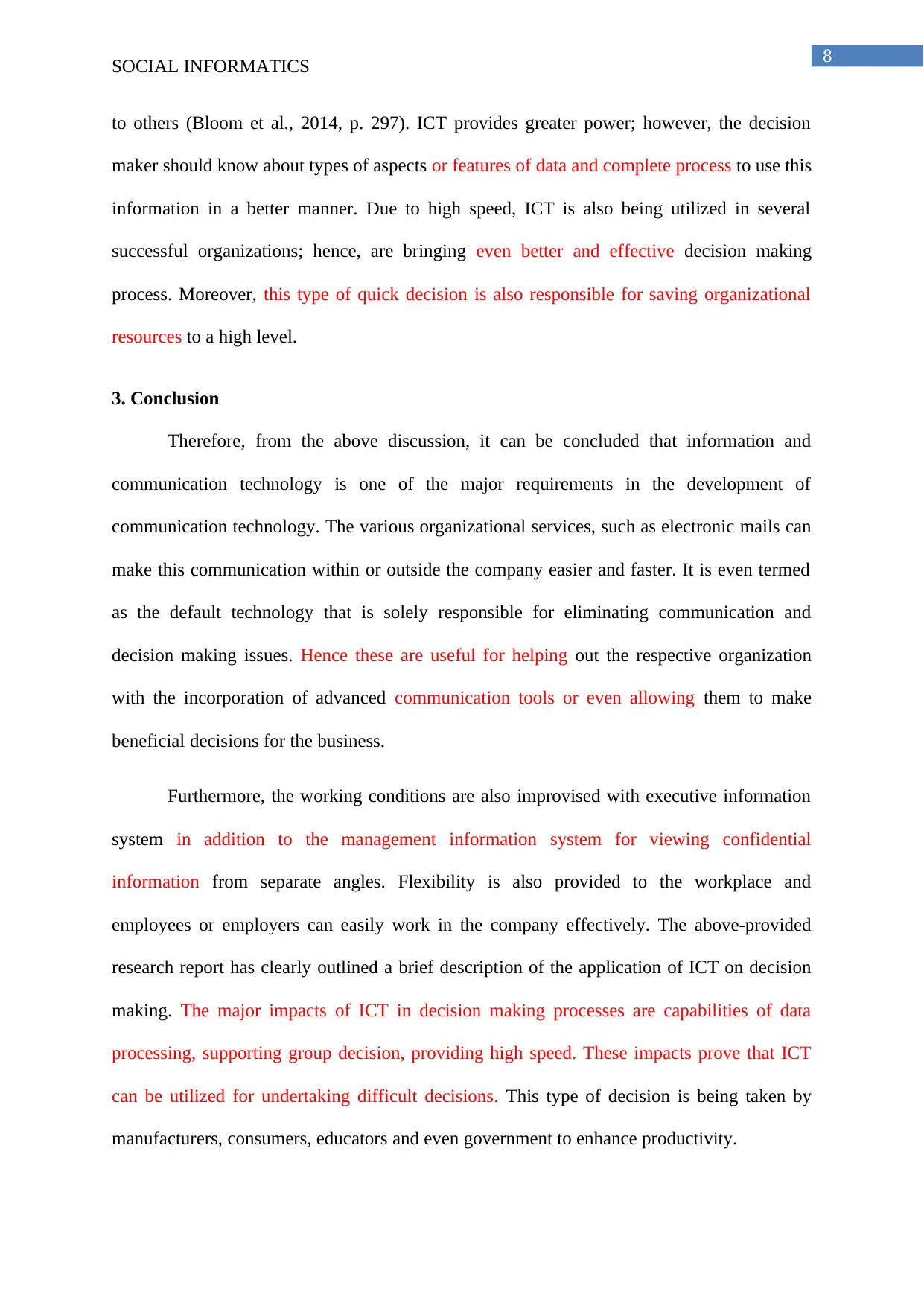
8
SOCIAL INFORMATICS
to others (Bloom et al., 2014, p. 297). ICT provides greater power; however, the decision
maker should know about types of aspects or features of data and complete process to use this
information in a better manner. Due to high speed, ICT is also being utilized in several
successful organizations; hence, are bringing even better and effective decision making
process. Moreover, this type of quick decision is also responsible for saving organizational
resources to a high level.
3. Conclusion
Therefore, from the above discussion, it can be concluded that information and
communication technology is one of the major requirements in the development of
communication technology. The various organizational services, such as electronic mails can
make this communication within or outside the company easier and faster. It is even termed
as the default technology that is solely responsible for eliminating communication and
decision making issues. Hence these are useful for helping out the respective organization
with the incorporation of advanced communication tools or even allowing them to make
beneficial decisions for the business.
Furthermore, the working conditions are also improvised with executive information
system in addition to the management information system for viewing confidential
information from separate angles. Flexibility is also provided to the workplace and
employees or employers can easily work in the company effectively. The above-provided
research report has clearly outlined a brief description of the application of ICT on decision
making. The major impacts of ICT in decision making processes are capabilities of data
processing, supporting group decision, providing high speed. These impacts prove that ICT
can be utilized for undertaking difficult decisions. This type of decision is being taken by
manufacturers, consumers, educators and even government to enhance productivity.
SOCIAL INFORMATICS
to others (Bloom et al., 2014, p. 297). ICT provides greater power; however, the decision
maker should know about types of aspects or features of data and complete process to use this
information in a better manner. Due to high speed, ICT is also being utilized in several
successful organizations; hence, are bringing even better and effective decision making
process. Moreover, this type of quick decision is also responsible for saving organizational
resources to a high level.
3. Conclusion
Therefore, from the above discussion, it can be concluded that information and
communication technology is one of the major requirements in the development of
communication technology. The various organizational services, such as electronic mails can
make this communication within or outside the company easier and faster. It is even termed
as the default technology that is solely responsible for eliminating communication and
decision making issues. Hence these are useful for helping out the respective organization
with the incorporation of advanced communication tools or even allowing them to make
beneficial decisions for the business.
Furthermore, the working conditions are also improvised with executive information
system in addition to the management information system for viewing confidential
information from separate angles. Flexibility is also provided to the workplace and
employees or employers can easily work in the company effectively. The above-provided
research report has clearly outlined a brief description of the application of ICT on decision
making. The major impacts of ICT in decision making processes are capabilities of data
processing, supporting group decision, providing high speed. These impacts prove that ICT
can be utilized for undertaking difficult decisions. This type of decision is being taken by
manufacturers, consumers, educators and even government to enhance productivity.
⊘ This is a preview!⊘
Do you want full access?
Subscribe today to unlock all pages.

Trusted by 1+ million students worldwide

9
SOCIAL INFORMATICS
SOCIAL INFORMATICS
Paraphrase This Document
Need a fresh take? Get an instant paraphrase of this document with our AI Paraphraser
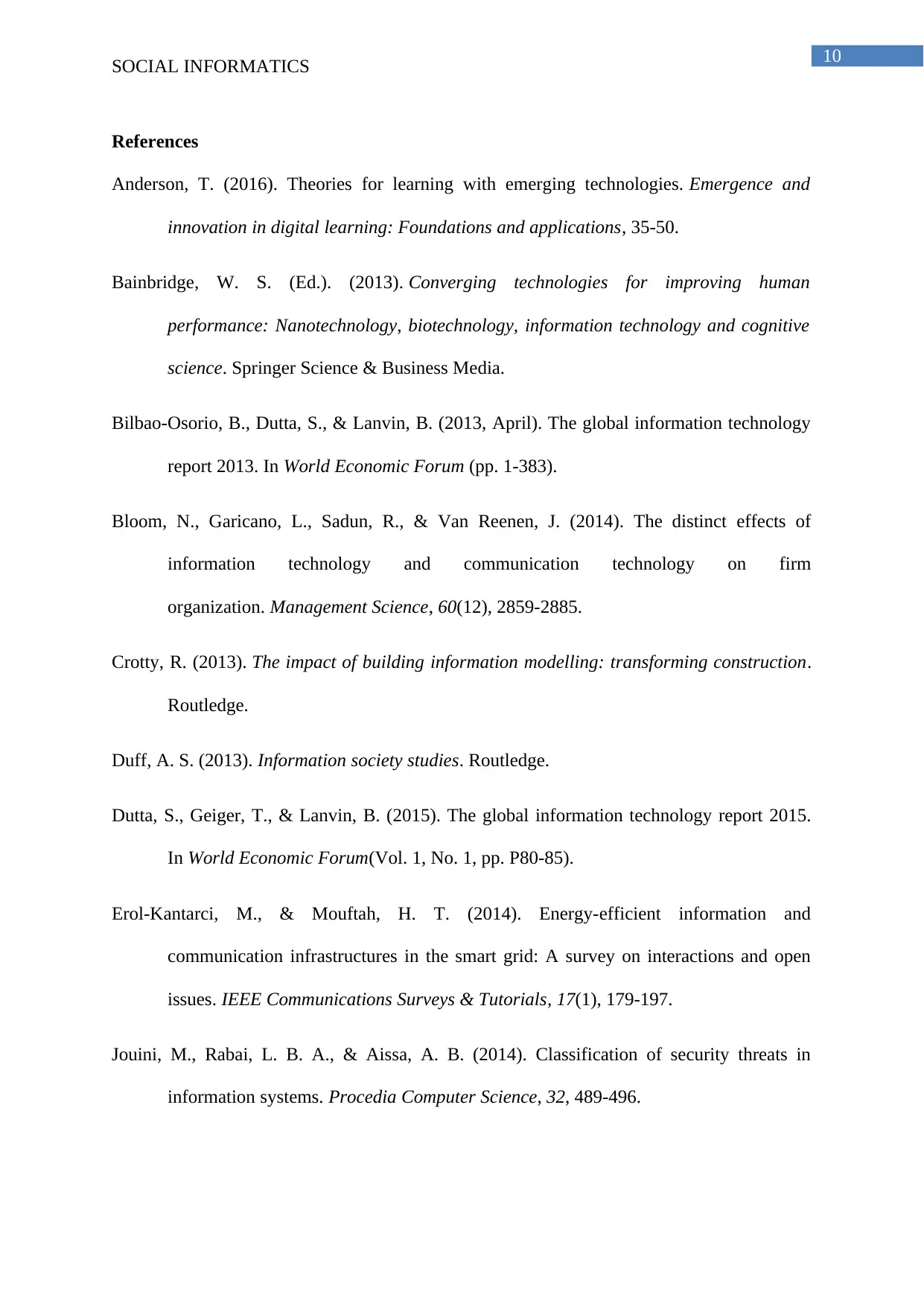
10
SOCIAL INFORMATICS
References
Anderson, T. (2016). Theories for learning with emerging technologies. Emergence and
innovation in digital learning: Foundations and applications, 35-50.
Bainbridge, W. S. (Ed.). (2013). Converging technologies for improving human
performance: Nanotechnology, biotechnology, information technology and cognitive
science. Springer Science & Business Media.
Bilbao-Osorio, B., Dutta, S., & Lanvin, B. (2013, April). The global information technology
report 2013. In World Economic Forum (pp. 1-383).
Bloom, N., Garicano, L., Sadun, R., & Van Reenen, J. (2014). The distinct effects of
information technology and communication technology on firm
organization. Management Science, 60(12), 2859-2885.
Crotty, R. (2013). The impact of building information modelling: transforming construction.
Routledge.
Duff, A. S. (2013). Information society studies. Routledge.
Dutta, S., Geiger, T., & Lanvin, B. (2015). The global information technology report 2015.
In World Economic Forum(Vol. 1, No. 1, pp. P80-85).
Erol-Kantarci, M., & Mouftah, H. T. (2014). Energy-efficient information and
communication infrastructures in the smart grid: A survey on interactions and open
issues. IEEE Communications Surveys & Tutorials, 17(1), 179-197.
Jouini, M., Rabai, L. B. A., & Aissa, A. B. (2014). Classification of security threats in
information systems. Procedia Computer Science, 32, 489-496.
SOCIAL INFORMATICS
References
Anderson, T. (2016). Theories for learning with emerging technologies. Emergence and
innovation in digital learning: Foundations and applications, 35-50.
Bainbridge, W. S. (Ed.). (2013). Converging technologies for improving human
performance: Nanotechnology, biotechnology, information technology and cognitive
science. Springer Science & Business Media.
Bilbao-Osorio, B., Dutta, S., & Lanvin, B. (2013, April). The global information technology
report 2013. In World Economic Forum (pp. 1-383).
Bloom, N., Garicano, L., Sadun, R., & Van Reenen, J. (2014). The distinct effects of
information technology and communication technology on firm
organization. Management Science, 60(12), 2859-2885.
Crotty, R. (2013). The impact of building information modelling: transforming construction.
Routledge.
Duff, A. S. (2013). Information society studies. Routledge.
Dutta, S., Geiger, T., & Lanvin, B. (2015). The global information technology report 2015.
In World Economic Forum(Vol. 1, No. 1, pp. P80-85).
Erol-Kantarci, M., & Mouftah, H. T. (2014). Energy-efficient information and
communication infrastructures in the smart grid: A survey on interactions and open
issues. IEEE Communications Surveys & Tutorials, 17(1), 179-197.
Jouini, M., Rabai, L. B. A., & Aissa, A. B. (2014). Classification of security threats in
information systems. Procedia Computer Science, 32, 489-496.
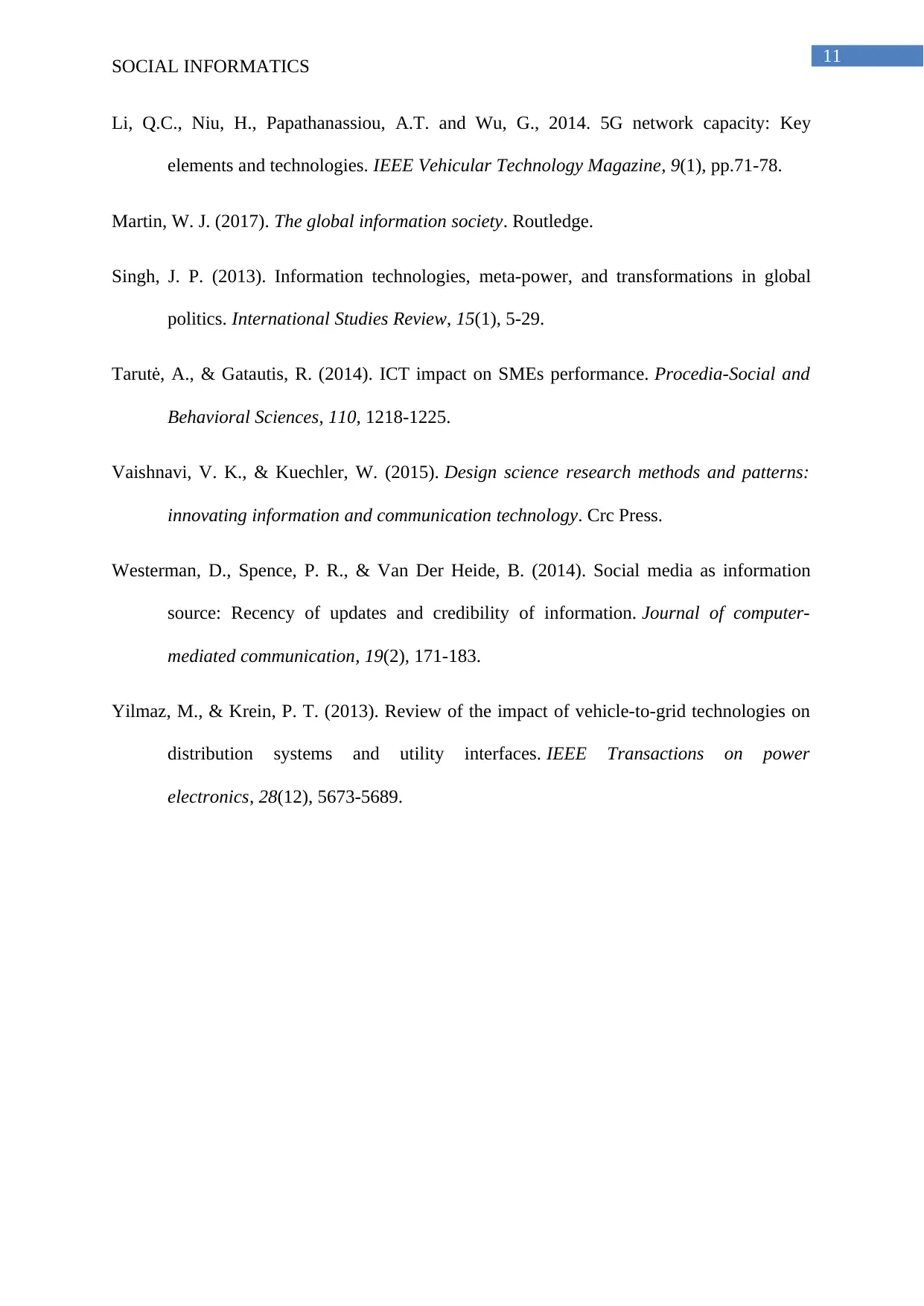
11
SOCIAL INFORMATICS
Li, Q.C., Niu, H., Papathanassiou, A.T. and Wu, G., 2014. 5G network capacity: Key
elements and technologies. IEEE Vehicular Technology Magazine, 9(1), pp.71-78.
Martin, W. J. (2017). The global information society. Routledge.
Singh, J. P. (2013). Information technologies, meta-power, and transformations in global
politics. International Studies Review, 15(1), 5-29.
Tarutė, A., & Gatautis, R. (2014). ICT impact on SMEs performance. Procedia-Social and
Behavioral Sciences, 110, 1218-1225.
Vaishnavi, V. K., & Kuechler, W. (2015). Design science research methods and patterns:
innovating information and communication technology. Crc Press.
Westerman, D., Spence, P. R., & Van Der Heide, B. (2014). Social media as information
source: Recency of updates and credibility of information. Journal of computer-
mediated communication, 19(2), 171-183.
Yilmaz, M., & Krein, P. T. (2013). Review of the impact of vehicle-to-grid technologies on
distribution systems and utility interfaces. IEEE Transactions on power
electronics, 28(12), 5673-5689.
SOCIAL INFORMATICS
Li, Q.C., Niu, H., Papathanassiou, A.T. and Wu, G., 2014. 5G network capacity: Key
elements and technologies. IEEE Vehicular Technology Magazine, 9(1), pp.71-78.
Martin, W. J. (2017). The global information society. Routledge.
Singh, J. P. (2013). Information technologies, meta-power, and transformations in global
politics. International Studies Review, 15(1), 5-29.
Tarutė, A., & Gatautis, R. (2014). ICT impact on SMEs performance. Procedia-Social and
Behavioral Sciences, 110, 1218-1225.
Vaishnavi, V. K., & Kuechler, W. (2015). Design science research methods and patterns:
innovating information and communication technology. Crc Press.
Westerman, D., Spence, P. R., & Van Der Heide, B. (2014). Social media as information
source: Recency of updates and credibility of information. Journal of computer-
mediated communication, 19(2), 171-183.
Yilmaz, M., & Krein, P. T. (2013). Review of the impact of vehicle-to-grid technologies on
distribution systems and utility interfaces. IEEE Transactions on power
electronics, 28(12), 5673-5689.
⊘ This is a preview!⊘
Do you want full access?
Subscribe today to unlock all pages.

Trusted by 1+ million students worldwide
1 out of 12
Related Documents
Your All-in-One AI-Powered Toolkit for Academic Success.
+13062052269
info@desklib.com
Available 24*7 on WhatsApp / Email
![[object Object]](/_next/static/media/star-bottom.7253800d.svg)
Unlock your academic potential
Copyright © 2020–2025 A2Z Services. All Rights Reserved. Developed and managed by ZUCOL.





